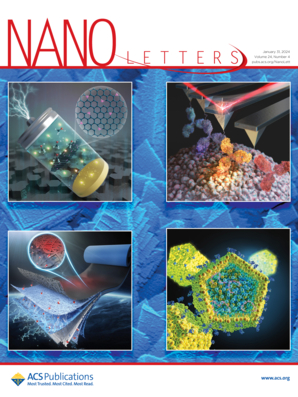Predicting and Accelerating Nanomaterial Synthesis Using Machine Learning Featurization
IF 9.6
1区 材料科学
Q1 CHEMISTRY, MULTIDISCIPLINARY
引用次数: 0
Abstract
Materials synthesis optimization is constrained by serial feedback processes that rely on manual tools and intuition across multiple siloed modes of characterization. We automate and generalize feature extraction of reflection high-energy electron diffraction (RHEED) data with machine learning to establish quantitatively predictive relationships in small sets (∼10) of expert-labeled data, saving significant time on subsequently grown samples. These predictive relationships are evaluated in a representative material system (W1–xVxSe2 on c-plane sapphire (0001)) with two aims: 1) predicting grain alignment of the deposited film using pregrowth substrate data and 2) estimating vanadium dopant concentration using in situ RHEED as a proxy for ex situ methods (e.g., X-ray photoelectron spectroscopy). Both tasks are accomplished using the same materials-agnostic features, avoiding specific system retraining and leading to a potential 80% time saving over a 100-sample synthesis campaign. These predictions provide guidance to avoid doomed trials, reduce follow-on characterization, and improve control resolution for materials synthesis.

利用机器学习功能化预测和加速纳米材料合成
材料合成优化受制于串行反馈过程,该过程依赖于多种孤立的表征模式下的手动工具和直觉。我们利用机器学习实现了反射高能电子衍射(RHEED)数据特征提取的自动化和通用化,从而在专家标记的小型数据集中(10 ∼ 10)建立了定量预测关系,为后续生长样品节省了大量时间。这些预测关系在具有代表性的材料系统(C-平面蓝宝石上的 W1-xVxSe2 (0001))中进行了评估,目的有两个:1) 利用生长前基底数据预测沉积薄膜的晶粒排列;2) 利用原位 RHEED 代替原位方法(如 X 射线光电子能谱)估算掺钒浓度。这两项任务均使用相同的材料无关特性来完成,避免了特定系统的重新培训,与 100 个样品的合成活动相比,可节省 80% 的时间。这些预测为避免失败试验、减少后续表征和提高材料合成的控制分辨率提供了指导。
本文章由计算机程序翻译,如有差异,请以英文原文为准。
求助全文
约1分钟内获得全文
求助全文
来源期刊

Nano Letters
工程技术-材料科学:综合
CiteScore
16.80
自引率
2.80%
发文量
1182
审稿时长
1.4 months
期刊介绍:
Nano Letters serves as a dynamic platform for promptly disseminating original results in fundamental, applied, and emerging research across all facets of nanoscience and nanotechnology. A pivotal criterion for inclusion within Nano Letters is the convergence of at least two different areas or disciplines, ensuring a rich interdisciplinary scope. The journal is dedicated to fostering exploration in diverse areas, including:
- Experimental and theoretical findings on physical, chemical, and biological phenomena at the nanoscale
- Synthesis, characterization, and processing of organic, inorganic, polymer, and hybrid nanomaterials through physical, chemical, and biological methodologies
- Modeling and simulation of synthetic, assembly, and interaction processes
- Realization of integrated nanostructures and nano-engineered devices exhibiting advanced performance
- Applications of nanoscale materials in living and environmental systems
Nano Letters is committed to advancing and showcasing groundbreaking research that intersects various domains, fostering innovation and collaboration in the ever-evolving field of nanoscience and nanotechnology.
 求助内容:
求助内容: 应助结果提醒方式:
应助结果提醒方式:


